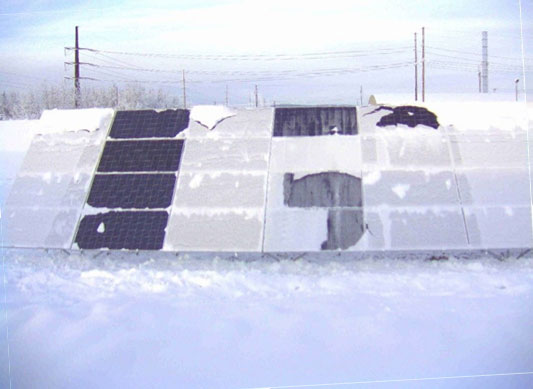Alaska trials of icephobic coating show 85% increase in energy output

A Sandia-led research team has developed a transparent, polymeric-based coating that helps photovoltaic panels continuously shed snow and ice.
Early field trials in Alaska demonstrated that coated panels can produce 85% more energy, compared to uncoated panels. Preliminary data also show that the coating maintains its ice- and snow-shedding performance for multiple months.
The DOE Solar Energy Technologies Office funded the work, and longer-term studies are planned.
“The development of icephobic coatings, which can be applied to photovoltaic modules without compromising light transmissivity, has game-changing potential for photovoltaic power plant efficiency in cold climates,” said Laurie Burnham, Sandia principal investigator for a larger project on photovoltaic optimization at northern latitudes. “Sandia is very proud of this coatings work, which was largely done at the University of Michigan and led by Sandia, with additional technical support provided by the University of Alaska, Fairbanks.”
The novelty of the coating lies in its dual properties of low-interfacial toughness and strength, which enable accelerated ice and snow shedding from large surfaces. While this coating has multiple applications besides solar panels, the technology’s impact on the solar industry is potentially huge. Solar panels that are covered by a thick layer of snow do not generate power, amounting to significant energy losses in winter — 1% to 12% annually for a northern photovoltaic site, with monthly losses as high as 100%. The rapid build-out of photovoltaics across the northern half of the U.S. magnifies the problem: as photovoltaic expands across regions of the U.S. that regularly see snow in winter, the risk of generation outages from those photovoltaic power plants increases.
Laurie said that snow-phobic coatings, such as the one developed by this team, could be an effective strategy to mitigate those losses and increase the resilience of photovoltaic installations across the more than 30% of the contiguous U.S. that sees significant snow in winter.
According to Anish Tuteja, a materials science and engineering professor at the University of Michigan, who led the coatings research, “Icephobic coatings work well for shedding ice, but the extremely diverse physical characteristics of snow make the design of a single, broad-spectrum de-icing, snow-phobic surface difficult. For this project, we developed the first optically transparent surfaces that possess both extreme low-interfacial strength and low-interfacial toughness.”
Next on the horizon is the continuation of long-term durability studies at multiple northern sites combined with economic analyses that include the amount of energy gained because of the rapid shedding of heavy snow from photovoltaic arrays.